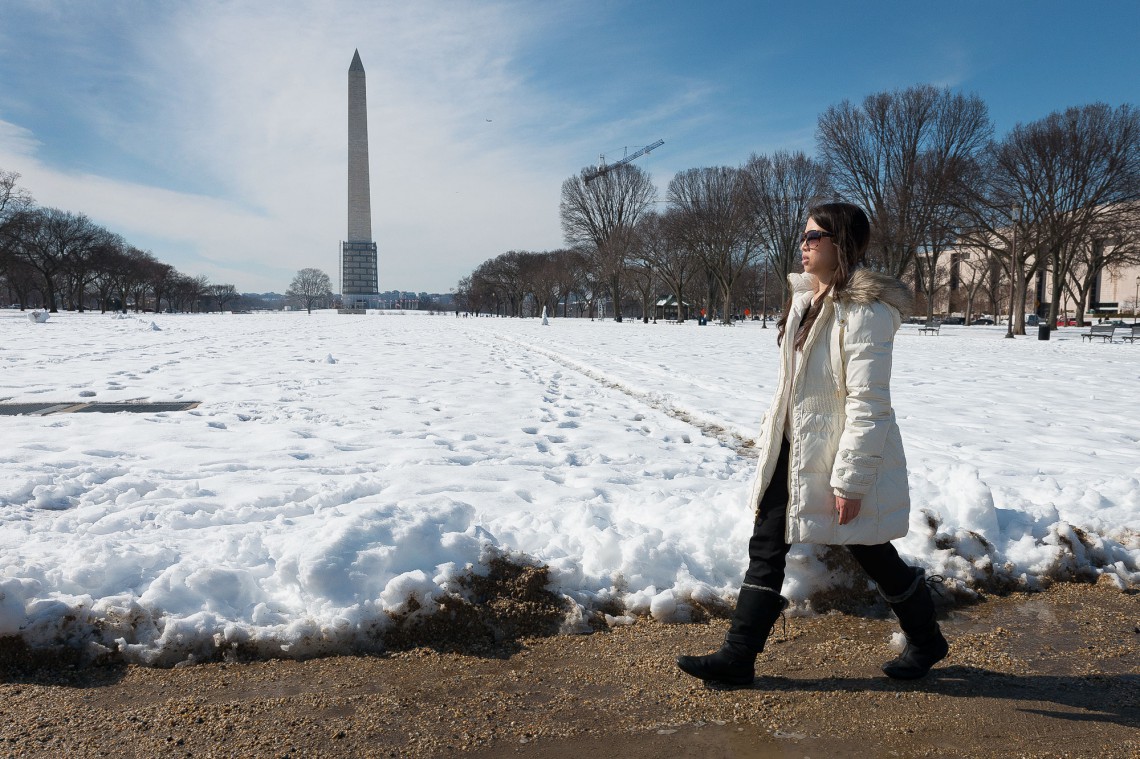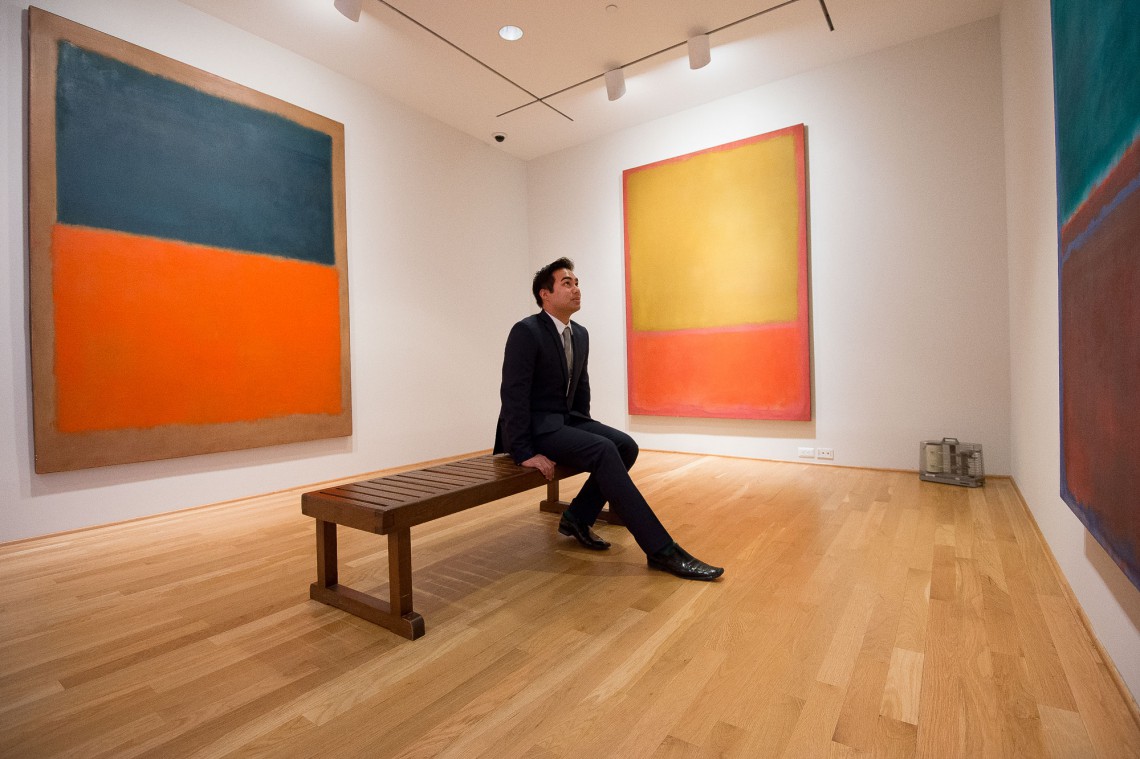Stanford inaugurates new academic arts program in Washington, D.C.
During winter quarter, the Bing Stanford in Washington Program offered its first quarter dedicated to the arts, with a new course, Art and the First Amendment: Testing the Freedom of Expression, taught by art history Professor Richard Meyer, and full-time internships in arts organizations.
After meeting Kale Futterman, an arts practice major at Stanford, the chief curator of the Corcoran Gallery of Art in Washington, D.C., entrusted her with an important task – writing short art history essays, known as “wall text,” to mount next to some of the gallery’s paintings.
Futterman created wall text for artists ranging from Camille Pissarro (1830-1903), a French landscape artist whose work influenced impressionism and post-impressionism, to Rineke Dijkstra, a contemporary Dutch photographer.
“In most instances, I was completely unfamiliar with the artist or their artwork, so research was a large component of the assignment,” said Futterman, who worked as a full-time intern at the Corcoran winter quarter, under the auspices of the Bing Stanford in Washington Program (SIW) and its new arts track.
“It was a great opportunity to analyze these artworks firsthand, up close and personal,” she said.
Futterman was one of seven students who participated in SIW’s inaugural winter arts track, which focused on visual art, arts administration, performance and theater.
In addition to the Corcoran internship, students enrolled in the winter arts program worked as interns at the African American Civil War Memorial & Museum, the National Museum of Women in the Arts, National Public Radio (NPR), The Phillips Collection, the Smithsonian Institution and the Washington Performing Arts Society.
The arts track cohort joined 14 students enrolled in SIW’s public policy track, which focuses on health and environmental policy in the winter quarter. All of the students worked five days a week as full-time interns. They lived and studied at the Bass Center, their home – and classroom – away from Stanford’s main campus. Stanford faculty, who also lived in the center, taught classes in the evening.
All of the winter-quarter courses – two in art history and six in health and environment – were open to all 21 students. So was a trip to New York City to see Broadway shows and art exhibitions. Cultural events, ranging from a visit to Gettysburg to a performance of the Alvin Ailey American Dance Theater, also brought all of the students together.
First SIW quarter dedicated to the arts
Adrienne M. Jamieson, SIW’s director, said the field trips, which have been offered since the program opened in 1988, were established with the generous support of Helen and Peter Bing, who are known for their devotion to the arts and culture and to Stanford.
“To some extent, the new arts track is a natural extension of our arts program,” Jamieson said. “We’ve had students working as interns in museums in the past. But this is the first time we’ve had a quarter dedicated to the arts.”
Jamieson said talks with scholars, as well as actors, singers, dancers and directors, enhanced the educational nature of the performances and tours.
“Virtually all of the performances we attended were interpreted by a participant or a scholar,” she said.
In New York, the students saw All the Way, a play about Lyndon B. Johnson’s push for the Civil Rights Act of 1964. They met with the assistant director, who discussed the challenges of capturing the late president on stage and the process of modifying the script in previews. Students also met with Brandon J. Dirden, who portrayed Martin Luther King Jr.
In Washington, D.C., the students spent a day touring African American history sites connected to the emergence of jazz and blues. John Coppola, former head curator of the Smithsonian, led the tour.
“The Washington Jazz Arts Institute and a group of local actors and vocalists capped the day with a special performance for us that captured the lives of Duke Ellington, Ethel Waters, Billy Strayhorn, Ella Fitzgerald and Lena Horne at the Duke Ellington School for the Arts, a public high school dedicated to arts education,” Jamieson said.
Art and the First Amendment
Richard Meyer, the Robert and Ruth Halperin Professor in Art History at Stanford, created a new course for the arts track, Art and the First Amendment: Testing the Freedom of Expression, which examined conflicts over freedom of expression in modern U.S. culture through the lens of American visual artists and photographers. He designed the course to bridge the interests of students enrolled in the new arts track and the existing public policy track.
Meyer, who joined the Stanford faculty in August 2012, said the winter arts program offered a “Washington-only experience” to students and faculty.
“The sense of creative inquiry and social connection that the program fosters allows Stanford students – and their teachers – to do things that would be impossible back in Palo Alto,” he said. “We saw The Fleet’s In!, a once-censored painting by Paul Cadmus that a curator at the Navy Art Gallery pulled out of storage for us. It’s one thing to learn about the painting and the controversy over it. It’s another thing to experience the painting, especially when the institution housing it is part of the story.”
Each week, the class examined a different case related to freedom of expression, from the role of photography in Japanese internment camps to the fate of Richard Serra’s Tilted Arc, a 1981 sculpture that the U.S. government commissioned, installed in a federal plaza in New York City and removed in 1989 following a legal battle with the sculptor. The class examined the controversies sparked by art, ranging from Maya Lin’s black granite Vietnam Veterans Memorial wall in the National Mall to Kara E. Walker’s room-size tableaux of black cut-paper silhouettes depicting scenes of antebellum slavery.
Wall text, disaster recovery, broadcasting and children’s choir
Futterman said learning about the controversial context of the various artists and artwork presented in the class helped heighten her engagement with the images.
“The class definitely changed my perspective of contemporary art and art movements,” said Futterman, whose own art focuses on photography and film. “It has added new meanings to my perception of the works I got to see in D.C.’s museums.”
She also pursued an independent photography project as a directed reading with her adviser at Stanford.
Angela Huang, ’13, who is pursuing a one-year coterminal master’s degree in management science and engineering, interned in the Office of the Undersecretary of History, Art and Culture at the Smithsonian Institution. Huang, who earned a bachelor’s degree in economics and in art practice, helped develop a business plan and three-year budget for the Cultural Crisis Recovery Center, a project in the early stages of planning and fundraising.
She said the center is envisioned as an organization that provides the essential elements needed to ensure the survival of a country’s endangered cultural heritage collections – such as statues, murals and paintings – in times of natural and man-made disasters.
The center would have three main components: disaster preparedness, including training, educational programs and university partnerships; disaster response, including deploying assessment, then salvage and operations teams to the disaster site; and disaster recovery, including long-term conservation and sustainability.
“What I valued most about my internship was the cause that I was working for,” she said.
“In the event of a disaster, humanitarian response is always the first priority,” Huang said. “At the same time, we must not forget the importance of preserving cultural heritage, an irreplaceable record of a nation’s identity. As the world’s largest cultural and scientific research institution, the Smithsonian is leveraging its unique position and capabilities to make a real impact on cultural heritage preservation.”
Rob Franklin, a junior majoring in political science, interned on NPR’s Washington desk, where he shadowed political reporters, did research for stories and edited audio content for stories that aired on Morning Edition and All Things Considered.
Franklin, who has a theater background and a longstanding interest in the arts, plans to pursue a career in broadcasting.
“I definitely want to employ my interest in the arts as I pursue broadcasting,” he said. “I’m not entirely sure how that will manifest itself, but I think the production skills, reporting experience, attention to detail and sound that I’ve practiced in my internship are applicable to a bunch of careers that intersect broadcasting and the arts.”
Franklin said he was familiar with some of the artists he studied in Meyer’s class, but had never discussed them in the context of freedom of expression. He was especially fascinated with Kara E. Walker, an African American artist whose works have been controversial among blacks. He also took a civil rights law course and a directed reading course for students who wanted to propose and organize visits to sites related to African American history and culture.
He said one of the benefits of the program was getting to know and befriend a professor.
“I got to know Richard outside of class and learned more about his personal biography, life and personality,” Franklin said. “We all became friends with him. That fostered a lot of comfort in our classroom.”
Ana Figueroa, a junior majoring in science, technology and society who participated in the winter arts program, took classes in the public policy track – civil rights law, women’s and children’s health, and international environmental law.
She worked as an intern at the Washington Performing Arts Society, where she primarily worked with the WPAS Children of the Gospel Choir.
“I loved getting to know the kids,” she said. “I took care of them during the shows. They taught me how to dance.”
Figueroa helped coordinate the logistics of a Feb. 16 performance that involved the children’s choir, the WPAS Men and Women of the Gospel Choir and the Choral Arts Society of Washington. More than 300 singers presented Living the Dream…Singing the Dream, an annual concert honoring the memory of Martin Luther King Jr.
“Wow,” she remembered thinking at the concert, which was held in Kennedy Center Concert Hall. “I helped make this happen.”


